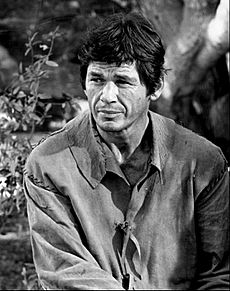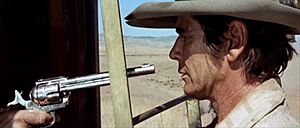Charles Bronson facts for kids
Quick facts for kids
Charles Bronson
|
|
|---|---|
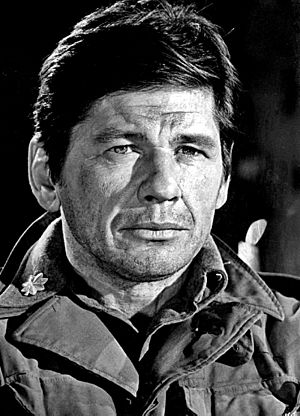
Bronson in 1965
|
|
| Born |
Charles Dennis Buchinsky
November 3, 1921 Ehrenfeld, Pennsylvania, US
|
| Died | August 30, 2003 (aged 81) Los Angeles, California, US
|
| Resting place | Brownsville Cemetery West Windsor, Vermont |
| Occupation | Actor |
| Years active | 1950–1999 |
| Spouse(s) |
Harriett Tendler
(m. 1949; div. 1965)Kim Weeks
(m. 1998) |
| Children | 4, including Katrina Holden Bronson |
| Military career | |
| Allegiance | |
| Service/ |
|
| Years of service | 1943–1946 |
| Rank | |
| Unit |
|
| Battles/wars | World War II |
Charles Bronson (born Charles Dennis Buchinsky; November 3, 1921 – August 30, 2003) was a famous American actor. He was known for his strong, tough look and muscular build. Charles Bronson became famous around the world for his main roles in action, Western, and war movies.
He often played tough characters who were strong and brave. In the early 1970s, he was one of the most popular actors globally. He even earned $1 million for each film he made.
Charles Bronson: A Tough Guy on Screen
Charles Bronson was born into a family of coal miners in Pennsylvania. His family was Lithuanian-American. During World War II, he served in the United States Army Air Forces. He was a tail gunner on a bomber plane.
After the war, he worked many different jobs. Then, he started his career in the film industry in the early 1950s. At first, he played small roles as tough guys or villains. He got his first main role in the crime movie Machine-Gun Kelly (1958). This role helped him get noticed by critics.
He then got bigger roles in popular films. These included The Magnificent Seven (1960) and The Great Escape (1963). He also starred in The Dirty Dozen (1967).
Even with his popularity, Bronson found it hard to get top roles in big Hollywood movies. But he became very popular with filmmakers in Europe. This led to many successful starring roles there. He played a vengeful gunman in Once Upon a Time in the West (1968). He also played a detective in Rider on the Rain (1970). These movies showed he could be a leading man. They made him an international star.
Back in the U.S., he became famous for playing Paul Kersey. This character was an architect who took justice into his own hands. He played this role in Death Wish (1974) and its four sequels. He continued acting into the 1980s. His last roles were in a series of TV movies called Family of Cops from 1995 to 1999.
In 1980, Charles Bronson received a star on the Hollywood Walk of Fame. This honored his important contributions to the film industry.
Early Life and World War II Service
Charles Dennis Buchinsky was born on November 3, 1921. He was the eleventh of fifteen children. His family was Roman Catholic and from Lithuania. They lived in Ehrenfeld, Pennsylvania, a coal mining area.
His father, Walter Buchinsky, was from Lithuania. His mother, Mary, was also of Lithuanian descent. She was born in a coal mining town in Pennsylvania.
Growing up, Bronson did not speak English at home. He spoke Lithuanian, Russian, and Greek. He later said his accent was so strong in the army that people thought he was from another country.
When Bronson was 10 years old, his father passed away. Charles then started working in the coal mines. He first worked in the office, then in the mine itself. He earned about one dollar for each ton of coal he mined. He sometimes worked double shifts to earn a dollar a week. He recalled that his work was dangerous. Cave-ins were common in the mines.
His family was very poor during the Great Depression. Bronson often went hungry. His mother could not afford milk for his younger sister. So, she gave her warm tea instead. He once had to wear his sister's dress to school because he had no other clothes. Charles Bronson was the first in his family to finish high school.
Bronson worked in the mine until 1943. That year, he joined the United States Army Air Forces during World War II. He served as an aerial gunner on a Boeing B-29 Superfortress bomber. He flew 25 missions against the Japanese home islands. He received a Purple Heart medal for injuries he got in battle.
Starting His Acting Career
Acting Training and First Roles
After World War II, Bronson worked many different jobs. Then, he joined a theater group in Philadelphia. He later shared an apartment in New York City with another aspiring actor, Jack Klugman.
In 1950, he got married and moved to Hollywood. There, he took acting classes. He began to find small roles in movies. Until 1954, he was credited as Charles Buchinsky. His first film role was as a sailor in You're in the Navy Now (1951). He also appeared in The Mob (1951) and Pat and Mike (1952). In Pat and Mike, he played a boxer.
In 1952, he even boxed in a show with Roy Rogers. He also appeared on The Red Skelton Show as a boxer. In 1954, he changed his last name to Bronson. His agent suggested it because an Eastern European name might hurt his career. His first film as Charles Bronson was Vera Cruz (1954).
Becoming a Lead Actor
Bronson made a strong impression as a villain in the Western film Drum Beat. He then got a main role in Machine-Gun Kelly (1958). This was a crime movie about a real-life gangster. He also starred in other low-budget films like Gang War (1958).
On television, he played Mike Kovac in the detective series Man with a Camera (1958–1960). Kovac was a former combat photographer. Bronson also appeared in shows like Twilight Zone and Have Gun – Will Travel.
In 1960, he gained a lot of attention in The Magnificent Seven. He played one of seven gunfighters helping people who couldn't defend themselves. He earned $50,000 for this role. This movie made him very popular in places like the former Soviet Union.
He continued to get supporting roles in bigger films. In 1963, he co-starred in The Great Escape. He played Danny Velinski, a Polish prisoner of war who was claustrophobic. This was fitting, as Bronson himself was claustrophobic from his childhood work in the mines. The film was a huge success.
He also appeared in TV Westerns like The Travels of Jaimie McPheeters and Bonanza. In 1967, he had a great role in The Dirty Dozen. He played an Army prisoner. This film was a massive success. However, Bronson was still often a supporting actor in Hollywood.
Becoming a Star in Europe
Bronson became very famous in European films. While making Villa Rides, he was asked to co-star with Alain Delon in a French film called Adieu l'ami. This movie was a big hit in Europe.
Even more popular was Once Upon a Time in the West (1968). Bronson played a character named Harmonica. The director, Sergio Leone, thought he was a great actor. This film was the biggest hit in France in 1969.
He then starred in a French thriller, Rider on the Rain (1970). This film was also a huge success in France. It even won a Golden Globe Award for Best Foreign Language Film in Hollywood.
Bronson continued to star in French-Italian action films. These included Violent City (1970) and Cold Sweat (1970). He also played a real-life person, Joe Valachi, in The Valachi Papers (1972).
His fame overseas earned him a special Golden Globe award in 1972. It was for "World Film Favorite – Male."
Hollywood Stardom and Death Wish
In 1972, Bronson started making successful action films for United Artists. One of these was Chato's Land (1972). This was his first film with director Michael Winner. They worked together again on The Mechanic (1972) and The Stone Killer (1973).
By 1973, Charles Bronson was considered the world's top box office star. He was earning $1 million for each movie.
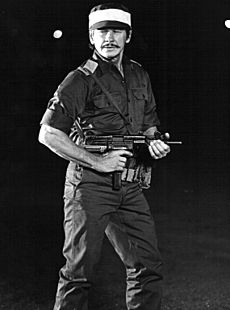
Bronson's most famous role came when he was 52 years old. This was in Death Wish, directed by Michael Winner. This movie was very popular. It led to four sequels over the next two decades, all starring Bronson.
He also starred in Hard Times (1975). In this film, he played a street fighter during the Great Depression. He received good reviews for this role. In 1975, he was the 4th highest-earning actor at the box office.
Later Career and Final Films
Between 1976 and 1994, Bronson earned high salaries. He starred in many films for smaller production companies. Many of his later films were made by Cannon Films.
He was paid $1.5 million by Cannon to star in Death Wish II (1982). This movie was a big success. He continued to make action films for Cannon, including 10 to Midnight (1983) and Death Wish 3 (1985).
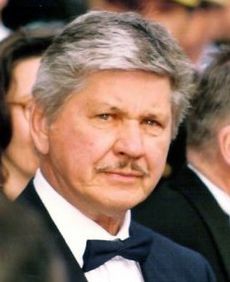
In Murphy's Law (1986), Bronson played a tough police detective. He also appeared in the TV movie Act of Vengeance (1986). In this film, he played a real-life union leader.
He made more action films for Cannon, such as Assassination (1987) and Death Wish 4: The Crackdown (1988).
Bronson's last starring role in a movie released in theaters was Death Wish V: The Face of Death (1994). His final films were a series of TV movies. These included Family of Cops (1995), Breach of Faith: A Family of Cops 2 (1997), and Family of Cops 3 (1999).
His Unique Acting Style
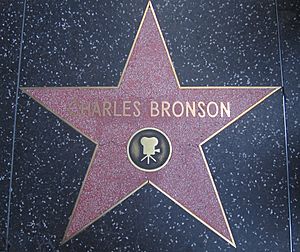
Film critic Stephen Hunter said that Bronson "always showed a strong male energy, quiet toughness, and strength." He added that Bronson "never became a great actor, but he knew exactly how to quietly control a scene."
Bronson once told a critic in 1974 that he was "only a product like a cake of soap, to be sold as well as possible." He said that in his action movies, there wasn't much time for deep acting. He explained, "I provide a presence. There are never any long talking scenes to show a character. He has to be fully shown at the start of the movie, and ready to work."
Director Michael Winner said that Bronson had a "quality that the movie camera seemed to like." He added, "He has great strength on the screen, even when he's standing still. There is a depth, a mystery – you always feel something will happen."
Roles He Almost Played
Sergio Leone wanted Bronson to play the "Man with No Name" in A Fistful of Dollars. But Bronson turned it down, saying the script wasn't good. He also turned down roles in the sequels. Later, he did star in Leone's Once Upon a Time in the West (1968).
Famous director Ingmar Bergman wanted to make a film with Bronson. But Bronson said no. He felt Bergman's films were too focused on weakness and sickness.
He was considered for the role of Snake Plissken in Escape from New York (1981). But the director thought he looked too tough and too old. So, Kurt Russell got the part instead.
Bronson also auditioned for the role of Superman for the 1978 film. But the producer thought he was too down-to-earth. Christopher Reeve was chosen instead.
Personal Life and Family
Bronson was affected by his difficult childhood and his early struggles as an actor. A newspaper article in 1973 said he was very shy. He was described as "still suspicious" and someone who "hates to give anything of himself." He was upset that it took so long for him to become famous in the U.S.
His first marriage was to Harriet Tendler. They met while both were new actors in Philadelphia. They had two children, Suzanne and Tony. They divorced in 1965. Harriet supported them both while they pursued their acting dreams.
Bronson married English actress Jill Ireland on October 5, 1968. They were married until her death in 1990. He had met her in 1962. At the time, she was married to actor David McCallum. Bronson reportedly told McCallum, "I'm going to marry your wife."
The Bronsons lived in a large mansion in Los Angeles. They had seven children in total. These included two from his first marriage, three from her previous marriage (one adopted), and two of their own (Zuleika and Katrina, who was adopted). After they married, Jill Ireland often played his main female co-star. They starred in fifteen films together.
To keep their family close, they would travel together for filming. They also spent time at a farmhouse in West Windsor, Vermont. Jill Ireland raised horses there. The family also visited Snowmass, Colorado for winter holidays.
On May 18, 1990, Jill Ireland passed away at age 54. She had been battling breast cancer. In 1998, Bronson married for a third time to Kim Weeks. She was an actress. They were married for five years until Bronson's death in 2003.
Passing Away
Bronson's health declined in his later years. He stopped acting after having hip surgery in 1998. Charles Bronson passed away at age 81 on August 30, 2003. He died at Cedars-Sinai Medical Center in Los Angeles.
His death certificate listed "respiratory failure" and "metastatic lung cancer" as causes. Other factors included "chronic obstructive pulmonary disease" and "congestive cardiomyopathy." He was buried at Brownsville Cemetery in West Windsor, Vermont.
Filmography
| Year | Title | Role | Notes |
|---|---|---|---|
| 1951 | The Mob | Jack | Uncredited |
| The People Against O'Hara | Angelo Korvac | ||
| You're in the Navy Now | Wascylewski | ||
| 1952 | Bloodhounds of Broadway | "Pittsburgh Philo" Green | |
| Battle Zone | Private | ||
| Pat and Mike | Hank Tasling | Credited as Charles Buchinski | |
| Diplomatic Courier | Russian Agent | Uncredited | |
| My Six Convicts | Jocko | Credited as Charles Buchinsky | |
| The Marrying Kind | Eddie – Co-Worker at Plant | Uncredited | |
| Red Skies of Montana | Neff | ||
| 1953 | Miss Sadie Thompson | Pvt. Edwards | Credited as Charles Buchinsky |
| House of Wax | Igor | ||
| Off Limits | Russell | Uncredited | |
| The Clown | Eddie, Dice Player | ||
| Torpedo Alley | Submariner | ||
| 1954 | Apache | Hondo | Credited as Charles Buchinsky |
| Riding Shotgun | Pinto | ||
| Tennessee Champ | Sixty Jubel, the 'Biloxi Blockbuster' | ||
| Crime Wave | Ben Hastings | ||
| Vera Cruz | Pittsburgh | ||
| Drum Beat | "Captain Jack" Kintpuash | ||
| 1955 | Target Zero | Sgt. Vince Gaspari | |
| Big House, U.S.A. | Benny Kelly | ||
| 1956 | Jubal | Reb Haislipp | |
| Man with a Camera | Mike Kovac | ||
| 1957 | Run of the Arrow | Blue Buffalo | |
| 1958 | Gang War | Alan Avery | |
| When Hell Broke Loose | Steve Boland | ||
| Machine-Gun Kelly | Machine Gun Kelly | ||
| Showdown at Boot Hill | Luke Welsh | ||
| 1959 | Never So Few | Sgt. John Danforth | |
| 1960 | The Magnificent Seven | Bernardo O'Reilly | |
| 1961 | Master of the World | John Strock | |
| A Thunder of Drums | Trooper Hanna | ||
| 1962 | X-15 | Lt. Col. Lee Brandon | |
| Kid Galahad | Lew Nyack | ||
| 1963 | The Great Escape | Flt. Lt. Danny Velinski, 'The Tunnel King' | |
| 4 for Texas | Matson | ||
| 1965 | Guns of Diablo | Linc Murdock | Feature version of the final episode of The Travels of Jaimie McPheeters |
| The Sandpiper | Cos Erickson | ||
| Battle of the Bulge | Maj. Wolenski | ||
| The Bull of the West | Ben Justin | Theatrical release combining 2 episodes of The Virginian | |
| 1966 | This Property Is Condemned | J.J. Nichols | |
| The Meanest Men in the West | Charles S. Dubin | Theatrical release combining 2 episodes of The Virginian | |
| 1967 | The Dirty Dozen | Joseph Wladislaw | |
| 1968 | Guns for San Sebastian | Teclo | |
| Farewell, Friend | Franz Propp | ||
| Villa Rides | Rodolfo Fierro | ||
| Once Upon a Time in the West | Harmonica | ||
| 1969 | Twinky | Scott Wardman | |
| You Can't Win 'Em All | Josh Corey | ||
| 1970 | Rider on the Rain | Col. Harry Dobbs | |
| Violent City | Jeff Heston | ||
| 1971 | Cold Sweat | Joe Martin | |
| Someone Behind the Door | The Stranger | ||
| Red Sun | Link Stuart | ||
| 1972 | The Valachi Papers | Joe Valachi | |
| Chato's Land | Pardon Chato | ||
| The Mechanic | Arthur Bishop | ||
| 1973 | The Stone Killer | Lou Torrey | |
| Chino | Chino Valdez | ||
| 1974 | Mr. Majestyk | Vince Majestyk | |
| Death Wish | Paul Kersey | ||
| 1975 | Breakout | Nick Colton | |
| Hard Times | Chaney | ||
| Breakheart Pass | Deakin | ||
| 1976 | From Noon Till Three | Graham Dorsey | |
| St. Ives | Raymond St Ives | ||
| 1977 | Raid on Entebbe | Brig. Gen. Dan Shomron | |
| The White Buffalo | Wild Bill Hickok | ||
| 1978 | Telefon | Major Grigori Bortsov | |
| 1979 | Love and Bullets | Charlie Congers | |
| 1980 | Borderline | Jeb Maynard | |
| Caboblanco | Gifford Hoyt | ||
| 1981 | Death Hunt | Albert Johnson | |
| 1982 | Death Wish II | Paul Kersey | |
| 1983 | 10 to Midnight | Leo Kessler | |
| 1984 | The Evil That Men Do | Holland / Bart Smith | |
| 1985 | Death Wish 3 | Paul Kersey | |
| 1986 | Murphy's Law | Jack Murphy | |
| Act of Vengeance | "Jock" Yablonski | ||
| 1987 | Assassination | Jay Killion | |
| Death Wish 4: The Crackdown | Paul Kersey | ||
| 1988 | Messenger of Death | Garret Smith | |
| 1989 | Kinjite: Forbidden Subjects | Lieutenant Crowe | |
| 1991 | The Indian Runner | Mr. Roberts | |
| Yes, Virginia, there is a Santa Claus | Francis Church | ||
| 1993 | The Sea Wolf | Capt. Wolf Larsen | |
| Donato and Daughter | Sgt. Mike Donato | ||
| 1994 | Death Wish V: The Face of Death | Paul Kersey | |
| 1995 | Family of Cops | Paul Fein | |
| 1997 | Family of Cops 2 | ||
| 1999 | Family of Cops 3 |
See also
 In Spanish: Charles Bronson para niños
In Spanish: Charles Bronson para niños



